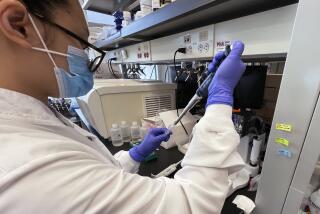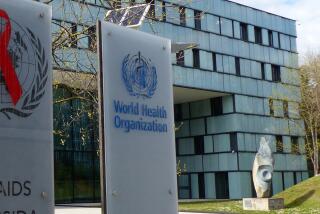BioWatch’s chief aim is off-target, U.S. security officials say
WASHINGTON — Homeland Security Department planners have privately rejected a central premise of BioWatch, the nation’s decade-old system for detecting biological weapons released into the air, according to government documents and testimony Tuesday at a congressional hearing.
Although BioWatch was designed with the belief that hostile foreign governments could sponsor large-scale germ attacks on American cities, the Homeland Security planners said they no longer saw this as the primary threat. They instead believe that small-scale releases of anthrax or other pathogens are the most plausible type of attack — but that these events would be least likely to be detected by BioWatch.
The only Homeland Security official to testify at the hearing, BioWatch Program Manager Michael V. Walter, said efforts were underway to improve BioWatch’s performance, but that he was unable to address decisions or actions that occurred before he joined the department in 2009. Walter’s testimony ultimately drew the ire of the congressional panel’s most senior Democrat, Rep. Henry A. Waxman of Beverly Hills.
“You’re the head of the program, you ought to know what happened,” Waxman said, alluding to the more than $1 billion spent to date on BioWatch and the department’s pending proposal to spend billions more to automate the system.
Called “Generation 3,” the automated system would expand BioWatch’s reach in both outdoor and indoor settings. BioWatch presently operates in more than 30 U.S. cities and at major spectator events, including sports championships and national political conventions.
The chairman of the congressional panel that convened Tuesday’s hearing, Rep. Tim Murphy (R-Pa.), questioned the worthiness of the current system and Generation 3.
“After 10 years of operation, we still don’t know if the current BioWatch technology can detect an aerosolized bioterrorism agent in a real-world environment,” Murphy said.
The oversight and investigations arm of the House Energy and Commerce Committee began examining BioWatch in July in response to reports in The Times about the system’s deficiencies.
Two Homeland Security scientists, Segaran Pillai and Douglas Drabkowski, have “cited a number of limitations” with BioWatch’s detection ability, called sensitivity, according to an investigative summary prepared by the Energy and Commerce Committee’s staff.
Pathogens released at low, yet infectious doses are “least likely” to be detected by BioWatch because of “the system’s lack of sensitivity,” the summary said.
At the hearing, Walter was pressed about his role in reviewing in advance the department’s earlier claims that BioWatch had never generated a false alarm.
Walter acknowledged that he had vetted one such public statement in July, when Chief Medical Officer Alexander Garza said there had been 37 “BioWatch actionable results.” A National Academy of Sciences expert panel and scientists at the U.S. Centers for Disease Control and Prevention have concluded those events were indeed false alarms.
By late 2012, a total of 149 BioWatch false alarms had been recorded. Garza’s statement — titled “The Truth About BioWatch” — had drastically understated the volume just a few months earlier.
“I reviewed it and I missed that,” Walter said, regarding Garza’s six-paragraph statement. “I should have caught it.”
Walter indicated under questioning that he thought the Homeland Security Department had promptly corrected the error. No such change, however, had been made.
As for Generation 3, Murphy suggested that spending billions for it would be inconsistent with the Homeland Security Department’s revised assumptions regarding a large-scale bioattack. The assumptions are outlined in the department’s bioterrorism risk assessments, conducted every two years.
“This costly approach is unbalanced and misdirected,” Murphy said. “It makes no sense to expand outdoor monitoring for a less likely large-scale attack, while not addressing the declining number of public health responders who are needed in any kind of attack.”
More to Read
Sign up for Essential California
The most important California stories and recommendations in your inbox every morning.
You may occasionally receive promotional content from the Los Angeles Times.











